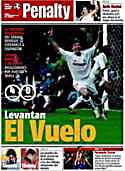
| Fit To Print |
 |
followthemedia.com - a knowledge base for media professionals |
|
|
AGENDA
|
||
More than 25 Million Free Dailies Now Distributed in 38 CountriesIt’s only 11 years since the idea was born of giving away newspapers from boxes at public transport stations and bus stops, and yet today more than 25 million such free papers are distributed in 38 countries in the world, according to Piet Bakker, the acknowledged expert on the free newspaper industry at the University of Amsterdam’s School of Communications Research. Spain's newest free newspaper, just in time for the World Cup And as good an example as any of why there has been such growth comes today in Switzerland when the country’s largest publishing house, Ringier, owner of Blick, the largest paid-for circulation newspaper in the country, launches the free afternoon paper Heute (Today) in the German speaking part of the country. Blick has had its nose bloodied for the past couple of years by the free 20 Minutes that now has sailed way ahead of Blick in readership. Blick tried just about everything it could to stop the rot, including turning itself into a tabloid, but 20 Minutes has seemingly gone from strength to strength with Blick languishing far behind. So today Ringier launches Heute with an initial press run of 200,000 with distribution in three major cities – Zurich, Bern, and Basle. In what could be recognition of 20 Minutes strength Heute goes out in the afternoon to catch the commuter on the way home, whereas 20 Minutes catches the commuter on the way to work in the morning. Ringier has some experience from its East European activities with free newspapers. It got its feet wet just last November in Prague with the launch of 24hodin and earlier this month it launched Compact in Bucharest with a print run of 150,000 expected to garner 300,000 daily readers. Ringier paid-for tabloids are number one in five East European countries -- The Czech Republic, Hungary, Romania, Slovakia, and Serbia. Elsewhere in Switzerland, Edipresse and Tamedia are still locking horns in the French-speaking part of the country. Lausanne-based Edipresse considers the French-speaking part of Switzerland its home turf and it launched the free Le Matin Bleu in October last year after it heard that Tamedia, the 20 Minutes brand holder in Switzerland having bought out Schibsted, was going to trespass from German-speaking Switzerland. Tamedia launched its French language edition of 20 Minutes in March, and both are distributed from similar looking blue boxes. 
There are days when the front pages of both tabloids look virtually the same – same layout, same main story, with picture below on a different subject, but both choosing the same subject for that picture. Maybe both staffs went to the same training courses for free newspapers! Difficult to tell who is winning the war, but mid-afternoon visits to the main Geneva distribution point – the central railway station where each newspaper has multiple boxes – continually shows the Le Matin Bleu boxes all empty, whereas the 20 Minutes boxes still are about one-quarter full. Whether that is because 20 Minutes is placing more papers in its boxes or Le Matin Bleu is just more popular will have to wait for official audit numbers.
Bakker points out that that reaching the 10 million global distribution in 2001 took just six years, and yet now the 25 million mark has been toppled in just five additional years. Among Bakker’s fascinating statistics:
There are some interesting trends. Established paid-for players are actively involved in the free newspaper business. Perhaps the best example is in the UK where the Daily Mail & Trust prints the Metro newspapers (no connection to the Swedish company) in several cities and is said to be making about £10 profit per reader this year. The fact that Ringier has a dominant position in its East European markets hasn’t stopped it from launching free dailies in two of those markets within the past six months. Advertisers are being offered cross-market packages – with the web sites of the free newspapers and also with their paid-for publications. And whereas most free newspapers are given out in the morning to catch the commuter going to work, the PM market is now gaining more interest, not only with Heute in Switzerland, but in London where the city is seeking bids for a PM franchise to use public transport areas for distribution, even using the same boxes as Metro uses in the morning. In the US, the Examiner tabloids in Washington and Baltimore are targeting home delivery to the neighborhoods advertisers are most interested in. And in Manchester, UK, where the Evening News is trying to have the best of both worlds – free and paid-for. In addition to its current 130,000 paid copies the newspaper is giving away 50,000 copies downtown. There has been no change to the advertising rates, but the Audit Bureau of Circulation has reclassified the newspaper as “free”. What publishers around the world will be looking at, of course, is whether it will also be classified as profitable! |
| copyright ©2004-2007 ftm partners, unless otherwise noted | Contact Us • Sponsor ftm |